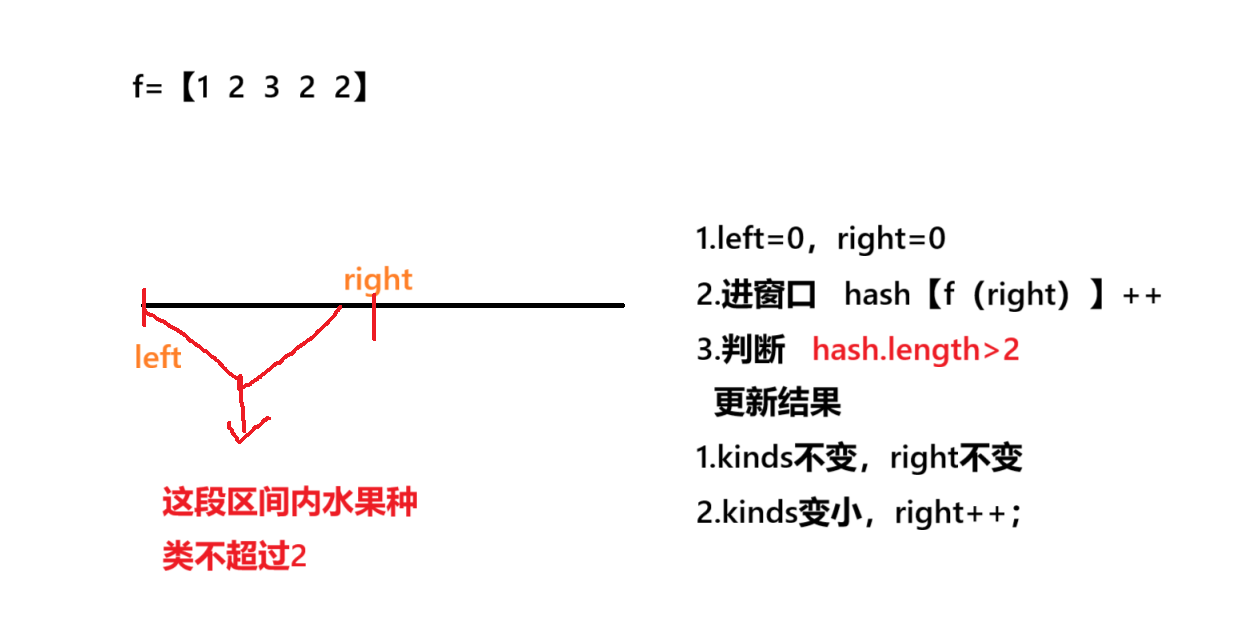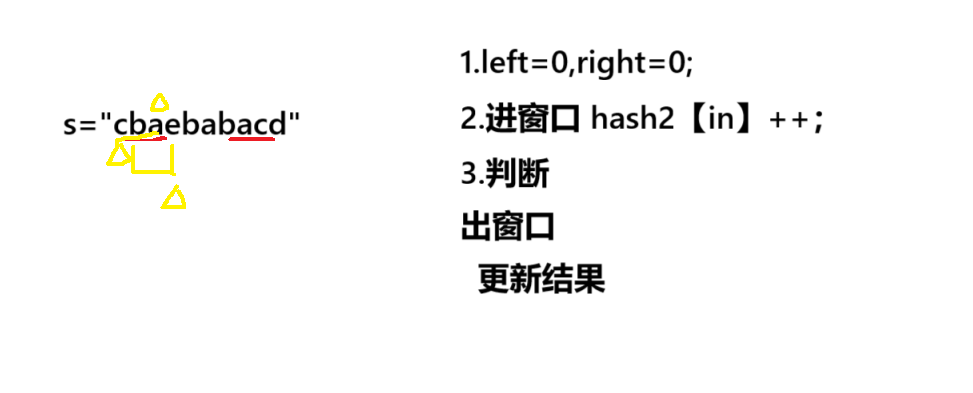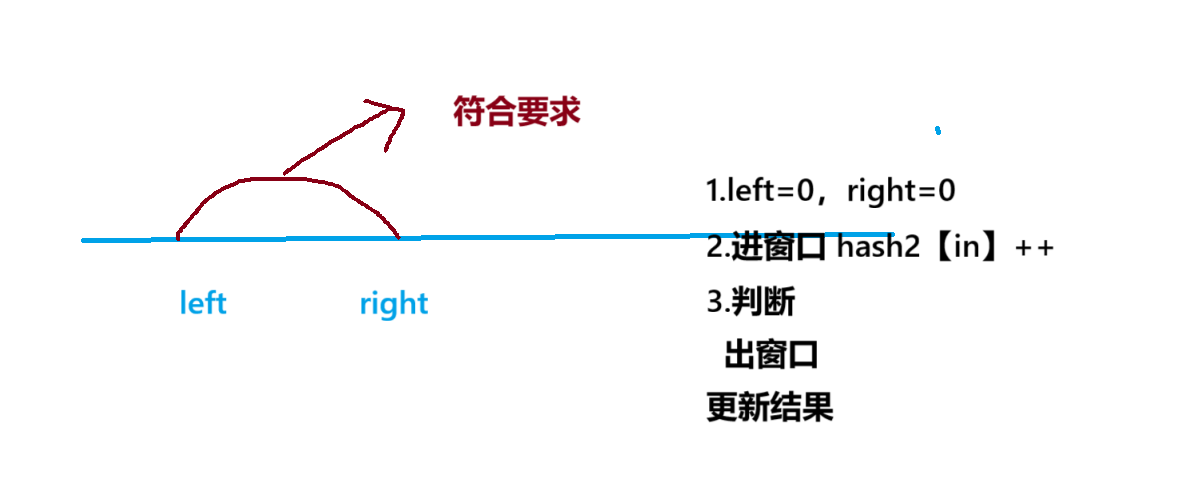算法--滑动窗口(二)
算法原理
滑动窗口
算法思路:
问题分析的对象一般是一段连续的区间
这个窗口寻找的是:以当前窗口最左侧元素(left1)为基准,符合条件的情况找到right,此时是left1的最优解
那么我们就可以大胆的把left1舍去,那么我们left右移,如果让right从头开始必然会有很多重复的计算,我们就可以让right先不动,如果不满足要求,那么right++,则可知left和right是同向移动的,不回退的,所以时间复杂度是O(N)
题目解析
https://leetcode.cn/problems/fruit-into-baskets/description/
1.水果成篮
题目解析
果树用fruits表示,fruits[i]是第i棵水果种类
要求:两个篮子,一个篮子一种水果,数量不限,每棵树上恰好摘一种,返回可以收集水果的最大数目
转换:找出最长的子数组(不超过两种水果)
算法原理
解法一:暴力枚举+哈希表
解法二:滑动窗口

代码实现
class Solution {public int totalFruit(int[] f) {int n=f.length;int[] hash=new int [n+1];int ret=0;for(int left=0,right=0,kinds=0;right<n;right++){int in=f[right];if(hash[in]==0){kinds++;}hash[in]++;while(kinds>2){int out=f[left];hash[out]--;if(hash[out]==0){kinds--;}left++;}ret=Math.max(ret,right-left+1);}return ret;}
}2.找到字符串中所有字母的异位词
https://leetcode.cn/problems/find-all-anagrams-in-a-string/description/
题目解析
给定字符串s和p,找到s中所有p的异位词子串,返回这些子串的起始索引

算法原理
解法一:暴力解法
解法二:滑动窗口+哈希表(注意这里滑动窗口的大小固定,为p的大小)

优化:更新结果的判断,在用哈希表的时候需要将两个哈希表中的每个元素进行对比
我们可以对这一点进行优化,利用变量count来统计窗口中“有效字符的个数”(那我们在进出,更新的时候都要进行维护)
代码实现
class Solution {public List<Integer> findAnagrams(String ss, String pp) {List<Integer> ret=new ArrayList<>();char[] s=ss.toCharArray();char[] p=pp.toCharArray();int[] hash1=new int[26];for(char c:p){hash1[c-'a']++;}int m=p.length;int[] hash2=new int [26];for(int left=0,right=0,count=0;right<s.length;right++){char in=s[right];if(++hash2[in-'a']<=hash1[in-'a']){count++;}if(right-left+1>m){char out=s[left++];if(hash2[out-'a']--<=hash1[out-'a']){count--;}}if(count==m){ret.add(left);}}return ret;}
}3.串联所有单词的子串
https://leetcode.cn/problems/substring-with-concatenation-of-all-words/description/
题目解析
给定一个字符串s和一个数组words(所有字符串长度相同)
s中的串联子串是指一个包含words中所有字符串以任意顺序排列连接起来的子串,返回所有串联子串在s中的索引(这个类似找出字母异位词)

算法原理
与上题类似
注意:1.哈希表<String,int> 2.left right的移动left和right移动的是一个单词的长度
3.滑动窗口执行次数(len次)
代码实现
class Solution {public List<Integer> findSubstring(String s, String[] words) {List<Integer> ret=new ArrayList<>();Map<String,Integer> hash1=new HashMap<String,Integer>();for(String str:words){hash1.put(str,hash1.getOrDefault(str,0)+1);}int len=words[0].length(),m=words.length;for(int i=0;i<len;i++){Map<String,Integer> hash2=new HashMap<String,Integer>();for(int left=i,right=i,count=0;right+len<=s.length();right+=len){String in=s.substring(right,right+len);hash2.put(in,hash2.getOrDefault(in,0)+1);if(hash2.get(in)<=hash1.getOrDefault(in,0))count++;if(right-left+1>m*len){String out=s.substring(left,left+len);if(hash2.get(out)<=hash1.getOrDefault(out,0)){count--;}left+=len;hash2.put(out,hash2.get(out)-1);}if(count==m){ret.add(left);}}}return ret;}
}4.最小覆盖子串
https://leetcode.cn/problems/minimum-window-substring/description/
题目解析
给定字符串s,t,返回s中涵盖t的所有字符的最小子串

算法原理
法一:暴力解法,可以借助HashMap
法二:滑动窗口+哈希表

在此基础上我们可以对判断条件进行优化,使用count来标记有效字符的种类
代码实现
class Solution {public String minWindow(String ss, String tt) {char[] s=ss.toCharArray();char[] t=tt.toCharArray();int[] hash1=new int[128];int kinds=0;for(char c:t){if(hash1[c]++==0){kinds++;}}int[] hash2=new int[128];int begin=-1,minlen=Integer.MAX_VALUE;for(int left=0,right=0,count=0;right<s.length;right++){char in=s[right];if(++hash2[in]==hash1[in]){count++;}while(count==kinds){if(right-left+1<minlen){begin=left;minlen=right-left+1;}char out=s[left++];if(hash2[out]--==hash1[out]){count--;}}}if(begin==-1){return new String();}else{return ss.substring(begin,begin+minlen);}}
}